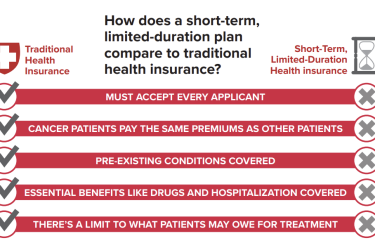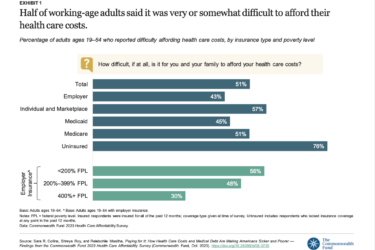For years, employers have been seeking to control the rising cost of employee health insurance. Now they have a new way to limit health care spending: the public and private health insurance exchanges.
The exchanges allow employers to shift from defined benefit plans to defined-contribution plans. In defined benefit plans, employers enroll their workers, family members, and retirees in health plans and offer other benefits such as dental and vision care. In defined-contribution plans, employers give employees and retirees a fixed sum that employees can spend on benefits options in the exchanges.
In USA Today, Jayne O’Donnell reported the link between the number of employers shifting to the exchanges and the move to defined-contribution plans. She quoted Wendell Potter, a freelance analyst for the Center for Public Integrity and former PR executive with Cigna, saying: “This is an irreversible trend from defined-benefit to defined-contribution employer-based health coverage. It is comparable to the move several years ago from pensions to 401(k)s.” Tom Murphy at The Associated Press also covered this trend.
The move to defined-contribution plans may make it difficult for health care journalists to track employers’ health insurance spending strategies in the coming years because employers likely will be reluctant to report how much they allot to each worker and retiree.
The combination of exchanges and defined-contribution plans is appealing to employers because it gives them an easy way to limit health insurance spending, a point Jerry Geisel made in Business Insurance. “The exchange model deploys a DC approach in which employers agree to provide a fixed premium contribution with employees paying more or less for their share of the total premium depending on the level of coverage they choose,” he wrote. “Through that approach, an employer can cap what it will pay for health care plan coverage for its employees.”
This point is important, because defined-contribution plans are another way for employers to shift costs to workers because contributions from employers may not keep pace with rising health care costs. Quoting Ron Pollack, executive director of nonprofit Families USA, O’Donnell explained that if companies keep paying the same amount to workers and retirees every year, the employer’s contribution will cover a smaller percentage if health insurance premiums continue to rise.
Not only do employers shift costs to workers and retirees, but, as Geisel pointed out, the employer’s role as a health plan sponsor is more limited. The exchanges negotiate premiums with insurers and answer questions and resolve problems for workers, family members, and retirees.
For these reasons, exchanges are attractive to employers, fueling a sharp rise away from traditional defined benefit plans as evidenced by the moves of Time Warner and IBM who recently shifted their retirees to exchanges and Walgreens which announced it would move its workers to a private exchange.
In five years, more than 25 percent of the estimated 170 million Americans currently covered by employer-sponsored health insurance will get their benefits on private exchanges, O’Donnell reported, citing research by the consulting firm Accenture, which predicts enrollment in public and private exchanges from 2014 through 2018, as this graphic depicts.
For health care journalists the move to exchanges and defined-contribution plans are trends to watch:
If health care costs continue to rise and a larger share of health care spending falls to workers, will families have limited funds to spend on other goods and services?










